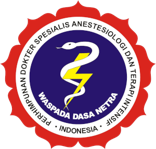Transnasal Sphenopalatine Ganglion Block as Management Pain for PDPH (Post Dural Puncture Headache)
Abstract
Background : Post dural puncture headache (PDPH) is a complication of the neuroaxial block anesthesia technique that cause leakage of cerebrospinal fluid (CSF) from a dural defect and intracranial hypotension. Typical symptoms, PDPH is bilateral, frontal, retroorbital or occipital headaches and extends into the neck constanly or slowly, and associated with photophobia and nausea. Management treatment of PDPH starting from conventional therapy (non-pharmacological and pharmacological) and invasive therapy including transnasal sphenopalatine ganglion block and as a gold standar is epidural blood patch that more invasive. Transnasal sphenopalatine ganglion block is a minimally invasive procedure on sphenopalatine ganglion which is an extracranial parasympathetic ganglion at fossa pterygopalatine. Various research state that efficacy of sphenopalatine ganglion block better than epidural blood patch.
Case Illustration : Reported a female, 37 years old came with headache extend to neck dan was diagnosed with PDPH post caesarean section with subarachnoid block anesthesia. Conservative therapy has been done but there is no improvement. As the next step, the patient transnasal sphenopalatine ganglion block using lidocaine 2% 3cc. The day after therapy, there is no complaint, VAS was 0-1 without complications and patient was allowed dismiss from hospital.
Conclusion : Transnasal sphenopalatine ganglion block is an invasive procedure as PDPH therapy that is very rarely performed. This action can be performed if the patient has undergone conventional therapy and there has been no improvement. With this case report, we can see that the efficacy of this procedure is very good and it is recommended before an epidural blood patch is performed.
Keywords
Full Text:
PDFReferences
- Butterworth J, Mackey D, Wasnick J. Morgan and Mikhail’s Clinical Anesthesiology. United States: McGraw Hill Medical; 2022. Chapter 45 : 1599p.
- Jankovic D, Peng P. Regional Nerve Blocks in Anesthesia and Pain Therapy. Fourth Edi. Switzerland: Springer; 2015. Chapter 11 : 162p.
- 3. Seale C, Day M. Sphenopalatine Ganglion Block. Essentials Interv Tech Manag Chronic Pain Second Ed [Internet]. 2022 Nov 16 [cited 2025 Oct 20];787–98. Available from: https://www.ncbi.nlm.nih.gov/books/NBK557751/
- Channabasappa SM, Manjunath S, Bommalingappa B, Ramachandra S, Banuprakash S. Transnasal sphenopalatine ganglion block for the treatment of postdural puncture headache following spinal anesthesia. Saudi J Anaesth [Internet]. 2017 Jul 1 [cited 2025 Oct 20];11(3):362. Available from: https://pmc.ncbi.nlm.nih.gov/articles/PMC5516510/
- Jespersen MS, Jaeger P, Ægidius KL, Fabritius ML, Duch P, Rye I, et al. Sphenopalatine ganglion block for the treatment of postdural puncture headache: a randomised, blinded, clinical trial. Br J Anaesth [Internet]. 2020;124(6):739–47. Available from: https://doi.org/10.1016/j.bja.2020.02.025
- Cohen S, Levin D, Mellender S, Zhao R, Patel P, Grubb W, et al. Topical Sphenopalatine Ganglion Block Compared With Epidural Blood Patch for Postdural Puncture Headache Management in Postpartum Patients: A Retrospective Review. Reg Anesth Pain Med [Internet]. 2018 Nov 1 [cited 2025 Oct 20];43(8):880–4. Available from: https://rapm.bmj.com/content/43/8/880
- Kent S, Mehaffey G. Transnasal sphenopalatine ganglion block for the treatment of postdural puncture headache in obstetric patients. J Clin Anesth [Internet]. 2016 Nov 1 [cited 2025 Oct 20];34:194–6. Available from: https://www.sciencedirect.com/science/article/abs/pii/S0952818016301209
- Albaqami MS, Alwarhi FI, Alqarni AA. The efficacy of sphenopalatine ganglion block for the treatment of postdural puncture headache among obstetric population. Saudi J Anaesth [Internet]. 2022 Jan 1 [cited 2025 Oct 20];16(1):45. Available from: https://pmc.ncbi.nlm.nih.gov/articles/PMC8846236/
- Santos NS, Nunes JM, Font ML, Carmona C, Castro MM. Early versus late sphenopalatine ganglion block with ropivacaine in postdural puncture headache: an observational study. Brazilian J Anesthesiol (English Ed [Internet]. 2023;73(1):42–5. Available from: https://doi.org/10.1016/j.bjane.2021.01.007
Refbacks
- There are currently no refbacks.








